Table of Contents
Fabric covered buttons have been a part of the button story from the early colonial days of Australian history. The first newspaper was the ‘The Sydney Gazette and New South Wales Advertiser’ published from the 5th March 1803. In May 1803, amongst goods for sale imported aboard the ship Rolla, were ‘shirt and other button moulds’.
Moulds have been made of wood, metal, bone, horn, linen and plastic. They have been covered with fabric, crocheted over or painted. Fabric covered button moulds have been embroidered and beaded. Tailors, dressmakers, sewing machine stores and department stores offered button and buckle covering services, especially once efficient button covering machinery was developed.
An amusing comment on covering your own buttons before mechanisation occurred comes from a book of 1861 called ‘Health, Husbandry, and Handicraft.”
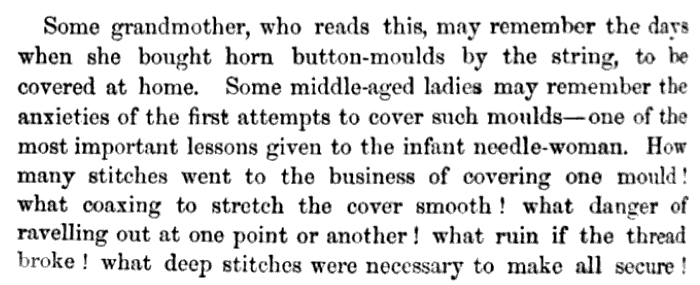

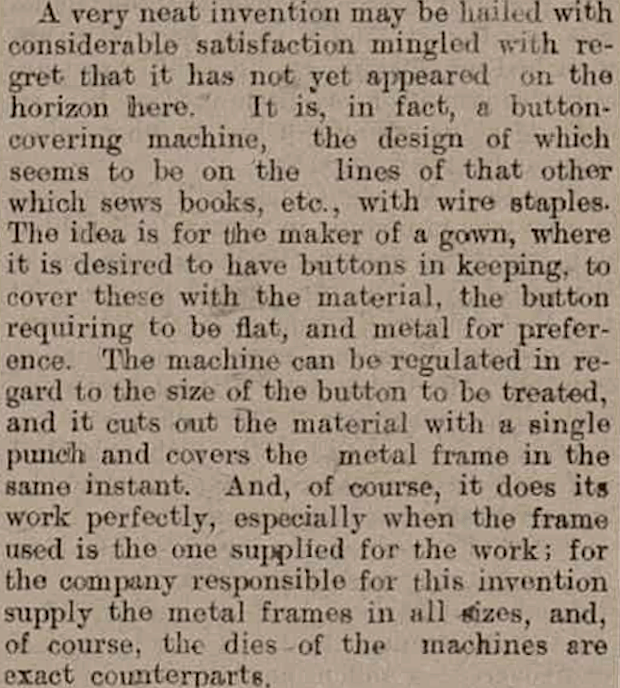
The Cumberland Argus and Fruitgrowers Advocate, 10th March 1906 page 6.
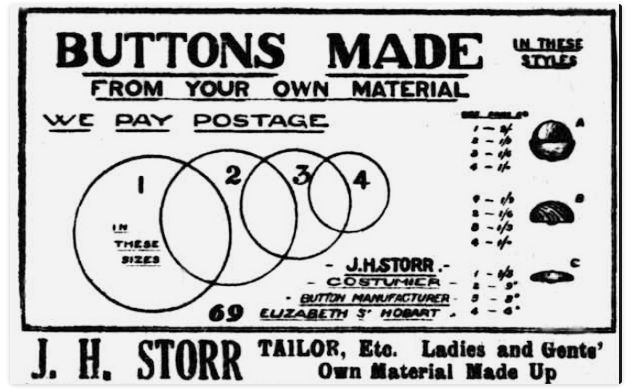
World (Hobart) 5th June 1920 page 3. Many tailors offered this service.
For examples of button moulds see http://www.austbuttonhistory.com/uncategorized/21st-august-2020-2/
For examples of covered buttons see http://www.austbuttonhistory.com/uncategorized/20th-august-2020/
Australian Buttons and Buckles Pty. Ltd., Dawson Street, Sydney
Godfrey Norman Shead was born in 1907. He served overseas in WW2 and returned, wounded, in 1941. He died the following year, aged only 34 years. He had been involved in several button manufacturing partnerships before the war. The first was in 1934 with James E. Campbell and George R. Sheidow in Whistler Street, Manly.

Dun’s Gazette for New South Wales, 1934, page 6.
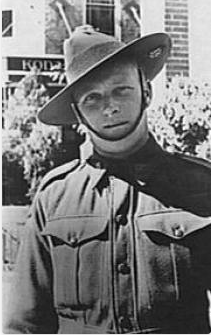
George Sheidow (from the now defunct Manly Council website archives).
This did not last long as the next year he was part of ‘Shead, Frost & Co’, whilst James Campbell continued alone.

Wise’s Post Office Directory 1936.
The new partnership dissolved in 12 months, when yet another version of the business was formed.
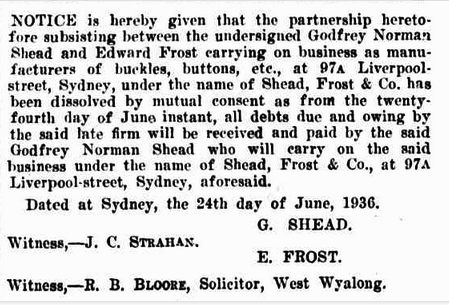
Government Gazette of NSW 10th July 1936 page 2897.
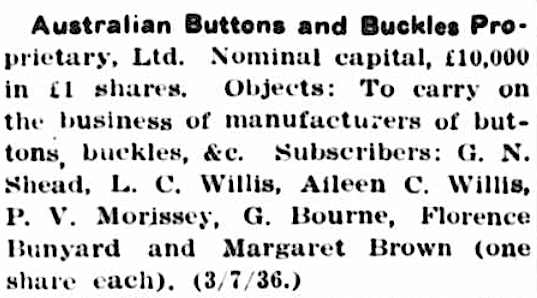
Daily Commercial News and Shipping List (Sydney) 15th July 1936.
They produced ‘Jiffy’ recoverable button molds. There was also the ‘Jiffy de Lux’ in gold or silver, which showed a ring of metal around the outside of the covered button. They also made casein buttons, but I am unaware of the branding of these. This company existed from 1936 until 1951, when they went into receivership. All the plant and stock were auctioned, including button presses, embossers, drills, cutters, tumblers, lathes, blanking machines as well as brass, zinc and casein, moulds and dies.
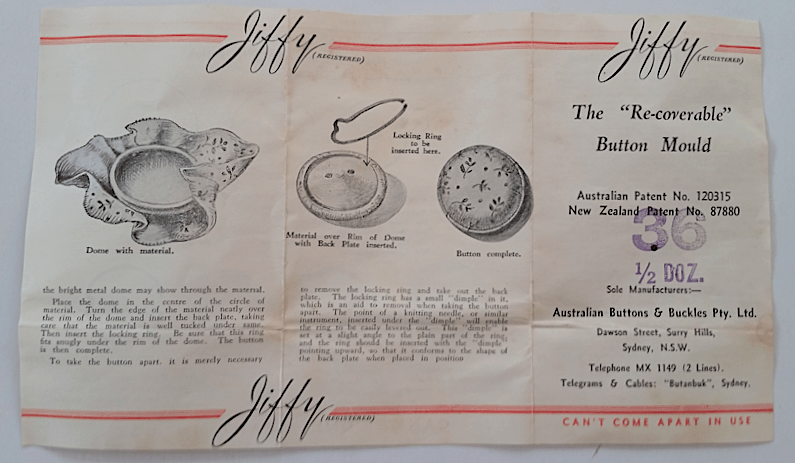
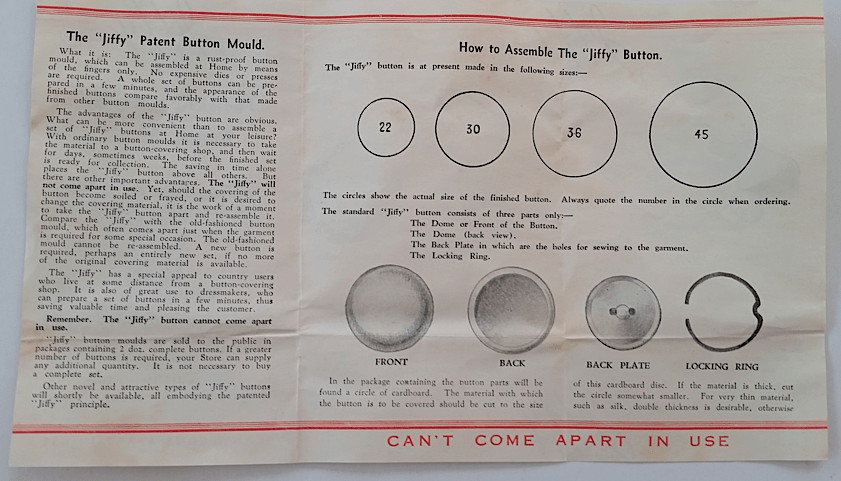
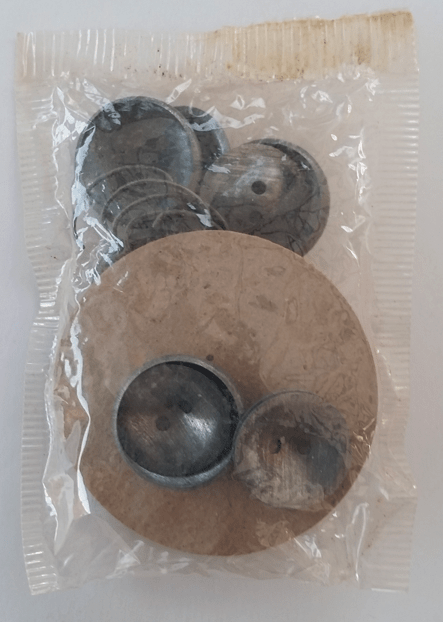
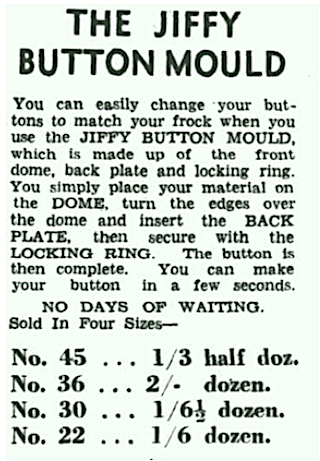
Morning Bulletin (Rockhampton), 13th February 1950 page 3.
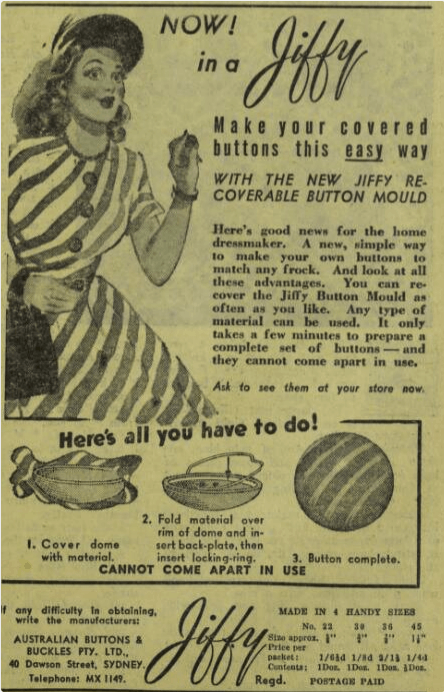
The Australian Woman’s Mirror, 14th September 1949 page 15.
A new company, ‘Jiffy Buttons P/L” formed in March 1951. One of the subscribers from 1936, George L. Bourne, had been involved with the original firm. It appears to have folded in 1958.

Dun’s Gazette April 1951.
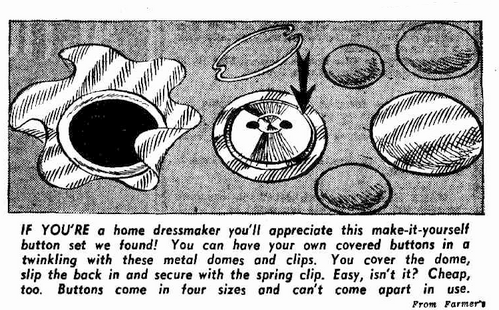
The Daily Telegraph (Sydney), 5th August 1954 page 26. Although not named, they look like Jiffy buttons.
Beutron
Beutron advertised these moulds from 1968-70. They also supplied Coles and Woolworths with branded moulds.
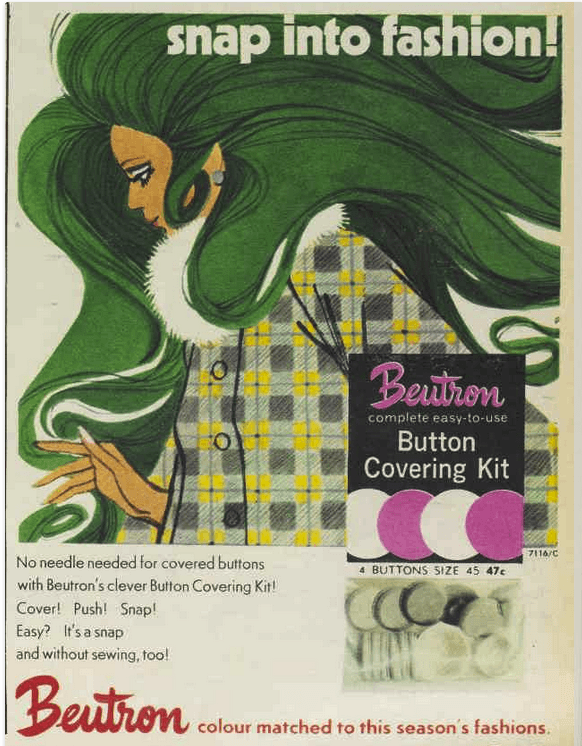
Australian Women’s Weekly, 16th April 1969 page 83.
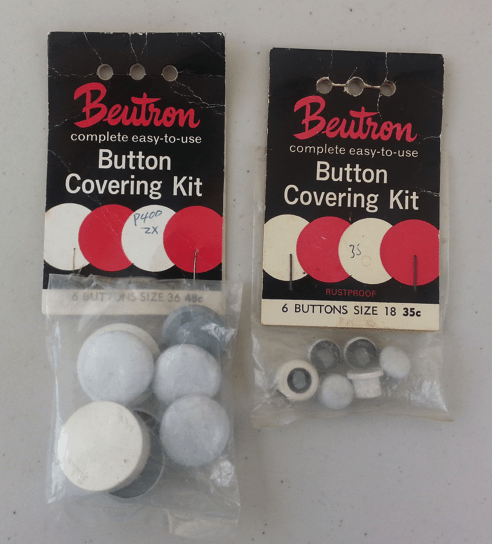

The Australian Women’s Weekly, 11th March 1970 page 85.
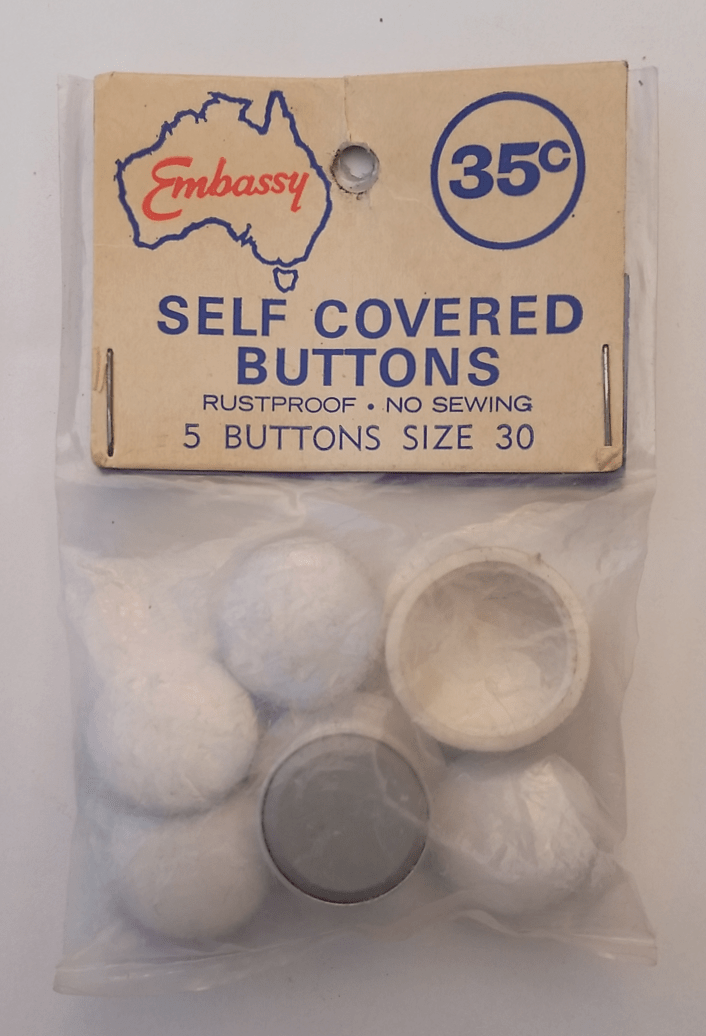
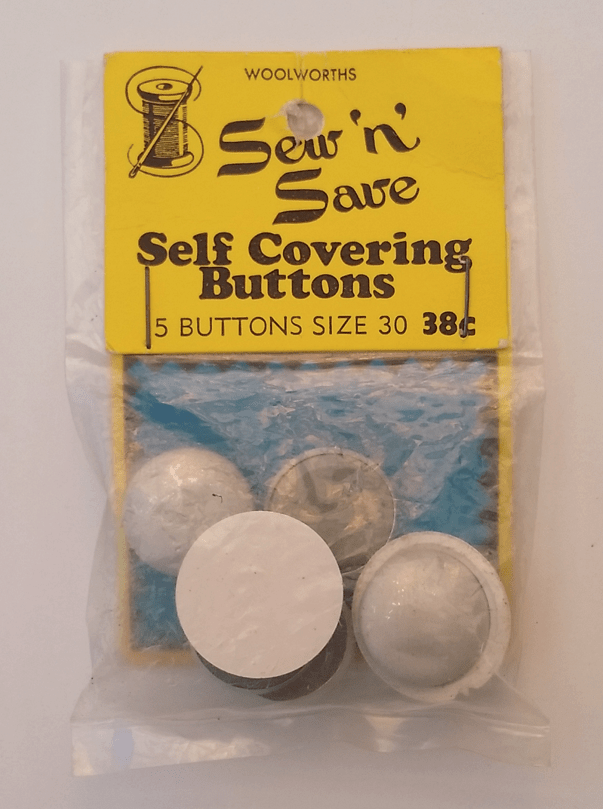
Eintex Manufacturing Co
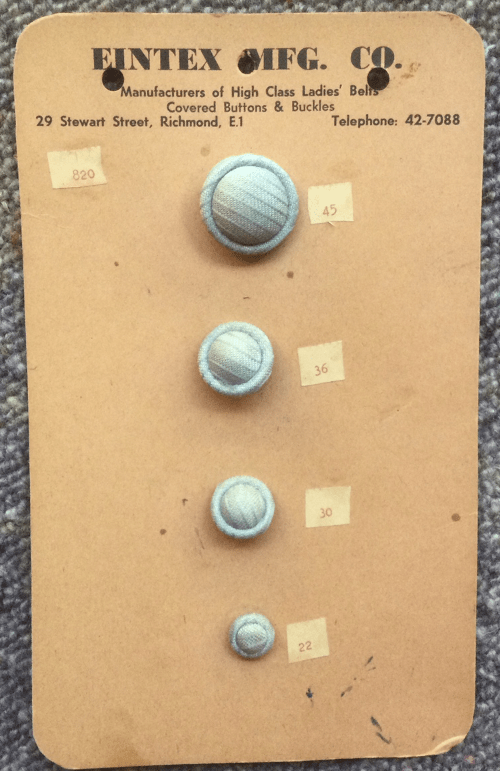
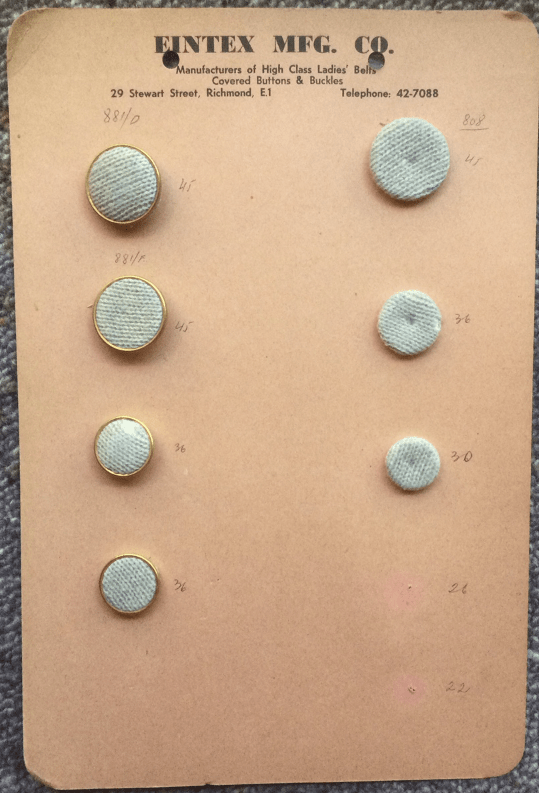

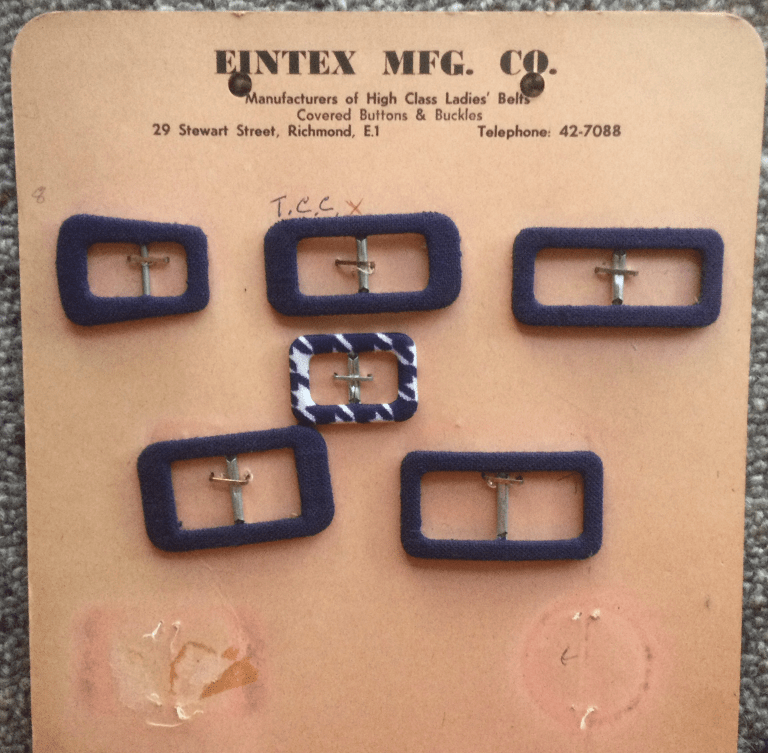
This company existed around 1951-63. The address is that of the Australian Knitting Mills, so the company had an office and/or workshop there.
Korbond
They were wholesale distributors who sold button moulds.
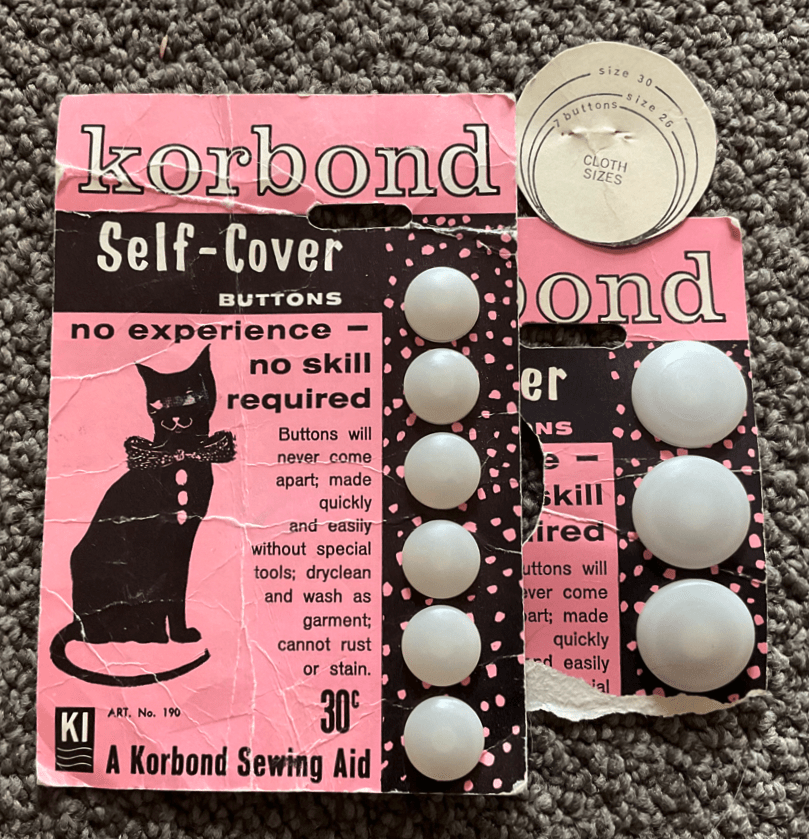
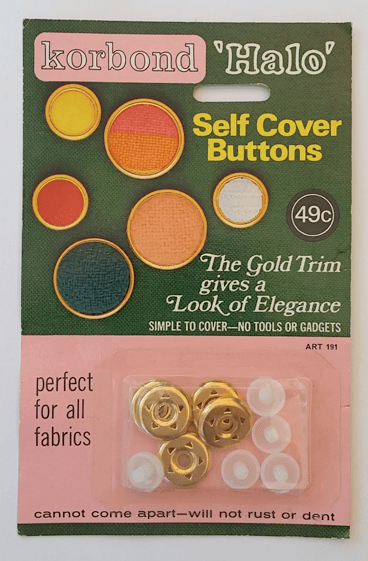
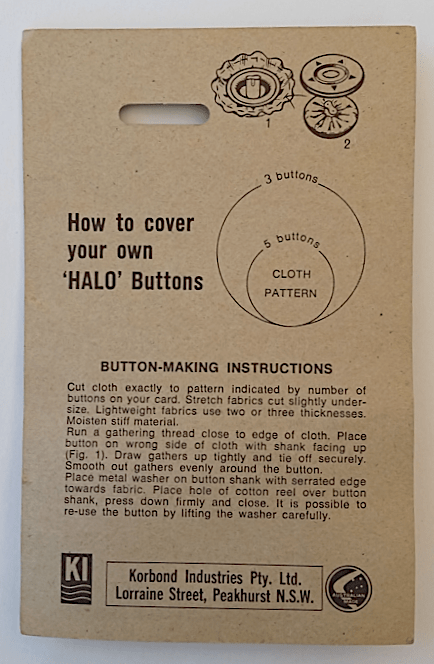
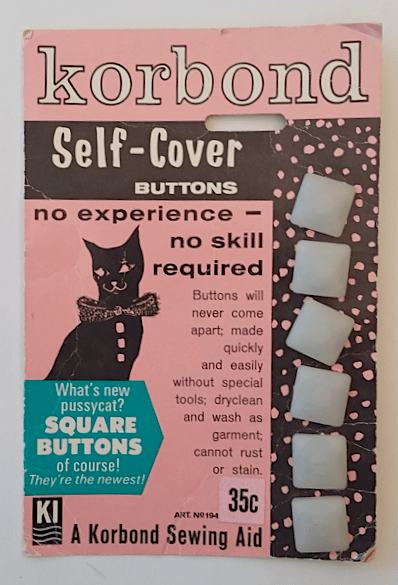
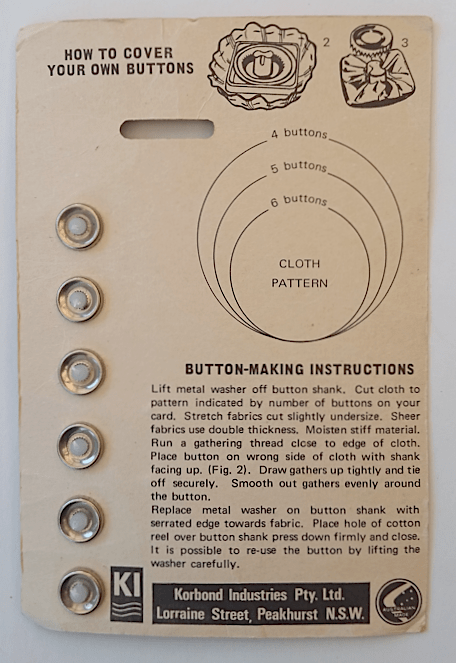
Leda
A button press branded “Leda” as in the line of buttons has been seen online.
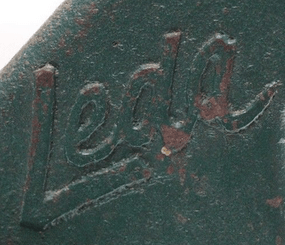
Many people and firms were involved in making covered buttons and buckles; this is just a sample of those involved.
The Lightning Button Company
This company made covered buttons. It expanded into pleating and then clothing manufacturing. In 1918 the company was registered by Elizabeth Viola Marduel. She was divorcing her husband and may have needed to support herself.
Dun’s Gazette Feb 1918.
It changed ownership in May 1920, but only several months later the owners dissolved their partnership, with Salah George Saleh continuing as sole proprietor.
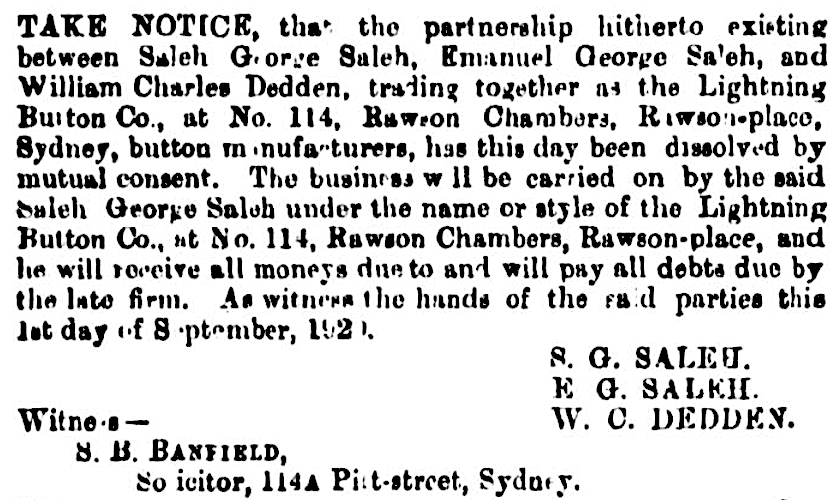
Government Gazette of NSW, 10th September 1920, page 5402.
In 1928 the firm became the Lightning Button and Pleating Company Ltd, and by 1937 it was a propriety limited company.
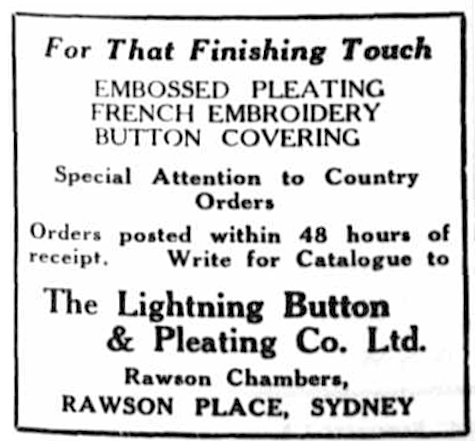
The Land, 3rd August 1928 page 19.
It found work during WW2 making khaki clothing for the Government, and in 1943 opened a clothing factory in Kiama.
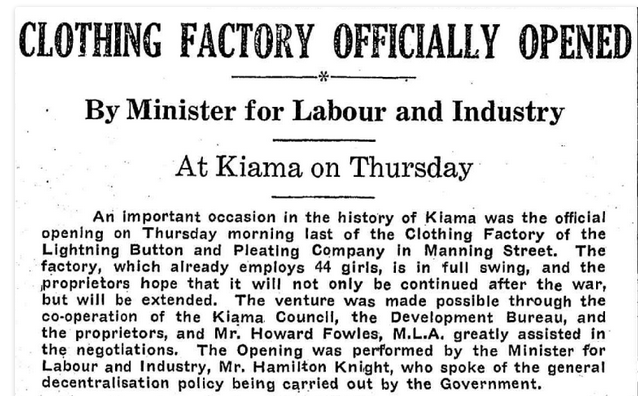
Kiama Independant & Shoalhaven Advertiser, 12th February 1944 page 1.
In 1950 Cladders Limited, a clothing company, bought shares in the company, so that it became a subsidiary of Cladders. This company was deregistered in 1992.
Buttonmania; Melbourne
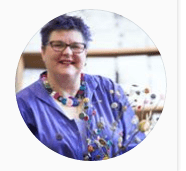
Kate Boulton: original owner of Buttonmania.
Kate bought a button Business in the Nicholas building around 1995 to sell imported, vintage and Australian craft buttons. A large part of her business was making bespoke buttons, buckles and belts, using an antique button covering machine. With this she supplied buttons for ballet and opera costumes as well as for exclusive fashion houses and design students. She sold the business in 2016 and it has moved to Highett, then Morabbin, where the tradition of covered buttons and buckles continues.
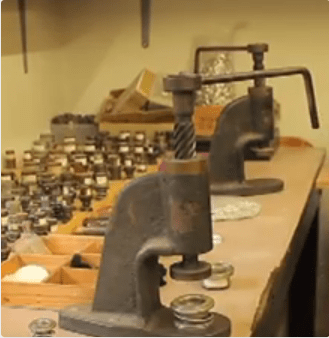
G. Marish: Sydney
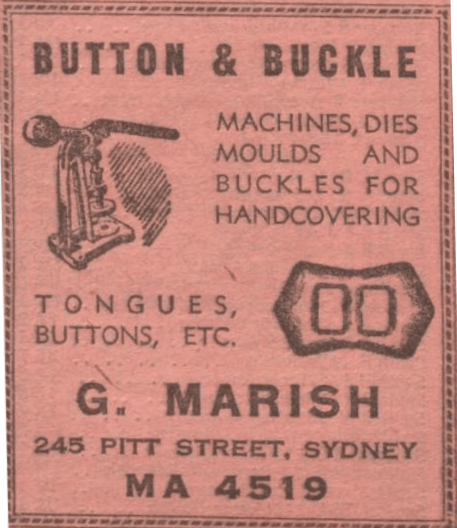
1947 Telephone Directory. G. Marish were haberdashery wholesalers.
Herrman, Hatfield and Co: Darlinghurst
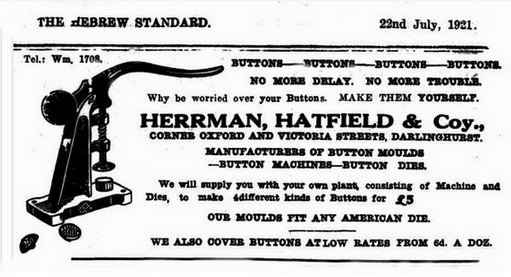
The Hebrew Standard, 22nd July 1921 page 8.
This company pre-dated the Herrman Company, which would eventually become General Plastic Pty. Ltd. Berthold Herrman was a pioneer of the plastic industry in Australia.
R. Pankhurt & Co/Pankys’ Pty. Ltd: Sydney
Apart from listings of British importers, the first button merchant (not manufacturer) listed within a Sydney directory was R. Pankhurst & Co in 1918.
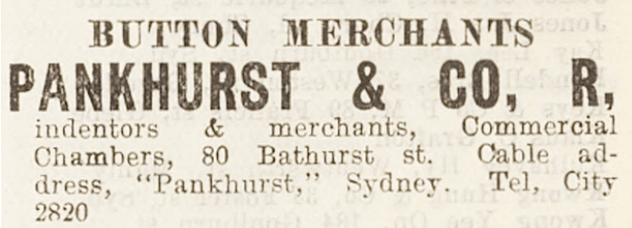
Robert Pankhurst had been importing buttons from Japan since at least 1915. In 1921 the company became a limited firm, however by 1928 the firm was in liquidation.

Dun’s Gazette for NSW, 14th November 1921 page 283.
In 1930 they reinvented themselves as “Panky’s”, who sold button covering and eyeletting machines.

Wise’s NSW Post Office directory 1930.
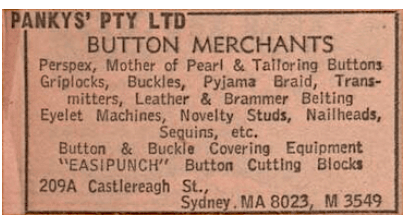
1950 Sydney telephone directory.
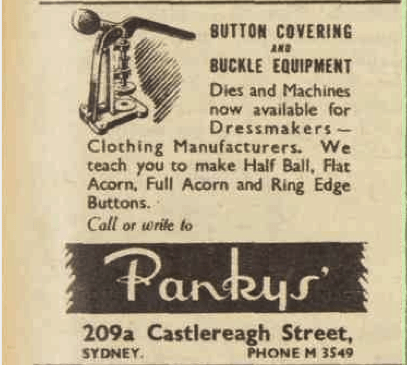
The Pankhurst’s new business. This ad was run from 1946-47 in many newspapers.
Tailors could make their own buttons using this type of equipment. Pankys’ advertised from around 1946 and went into liquidation in 1974.

1950 Sydney telephone directory.
R. J. Forbes Pty. Ltd. 49 Elizabeth Street, Melbourne
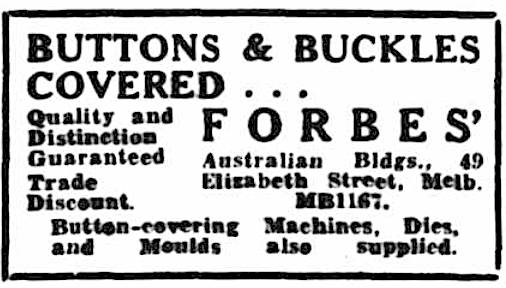
The Argus (Melbourne), 29th October 1947 page 11.
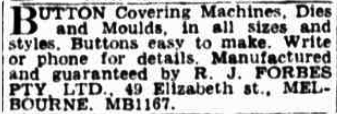
The Argus, 5th January 1957, page 32.
This company advertised from 1947 until at least 1965.
Wyeth, Besemeres & Co: South Melbourne
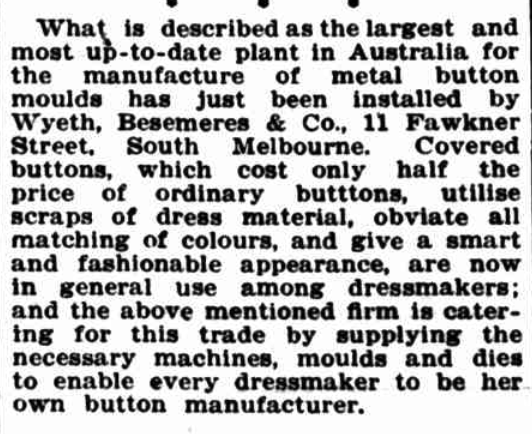
Daily Commercial News and Shipping List (Sydney), 13th April 1921 page 9.
In 1924 a fire destroyed the single story factory in Little Street, Middle Park, Melbourne. The company was described as manufacturers of buttons and bottle-seals, and had a workforce of about 50 ‘men and girls’. The fire was caused by an explosion of gas in a seal-making machine and caused an estimated £10,000 damage.
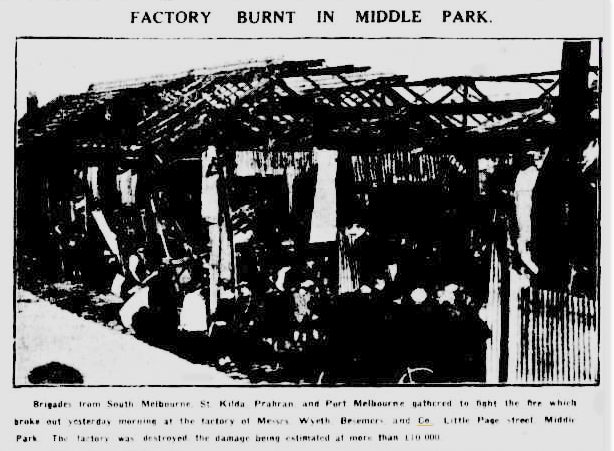
Published in The Argus (Melbourne), on 30th May 1924 page 7.
But worse was yet to come…. In 1927 Calvert William Wyeth, aged 30, petitioned for divorce of his wife, Dorothy who was secretary to the company. While Mr Wyeth was in America on business, his wife had become too friendly with Basil Besmeres, who was the married director and salesman for the company, as well as one of Wyeth’s closest friends.
Calvert Wyeth had served in WW1. He remarried in 1928 and from around 1938 was operating a private hotel in Inverloch, Victoria. He was nominated for the Victorian Parliament in 1940 and died in 1983.
At the time of the divorce, Basil Besmeres had already moved to Sydney, becoming an indent merchant, then a factory representative, then a company manager. He was born in Ballarat and, like Calvert, had served in WW1. He married Dorothy in 1930 but would later marry again. He died in Sydney in 1976.
W. Lesser & Co, Sydney

Dun’s Gazette of NSW, 1919.
Whilst there would be many button and buckle coverers, large and small, around Australia for many years, this firm had longevity, lasting until 1991.
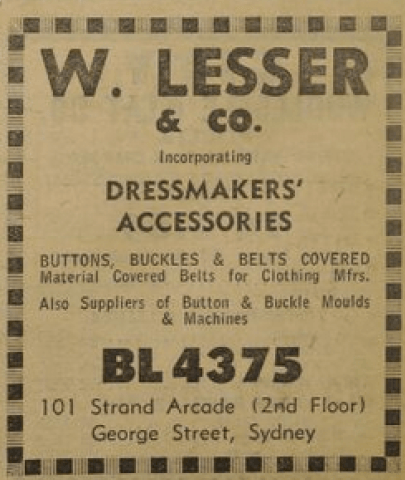
Sydney Pink Pages, 1960
